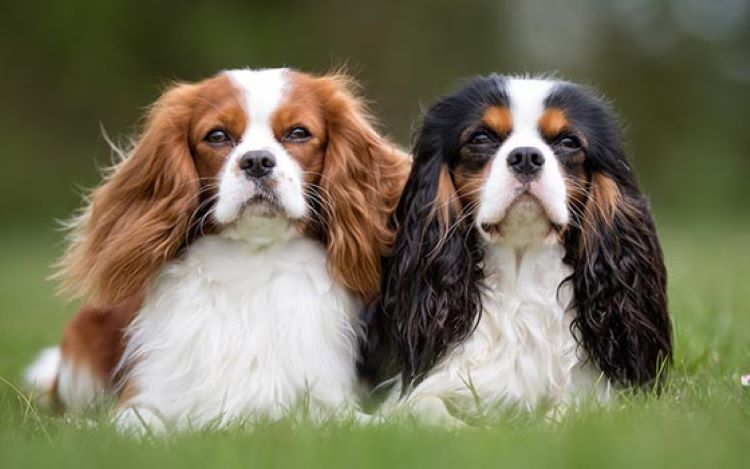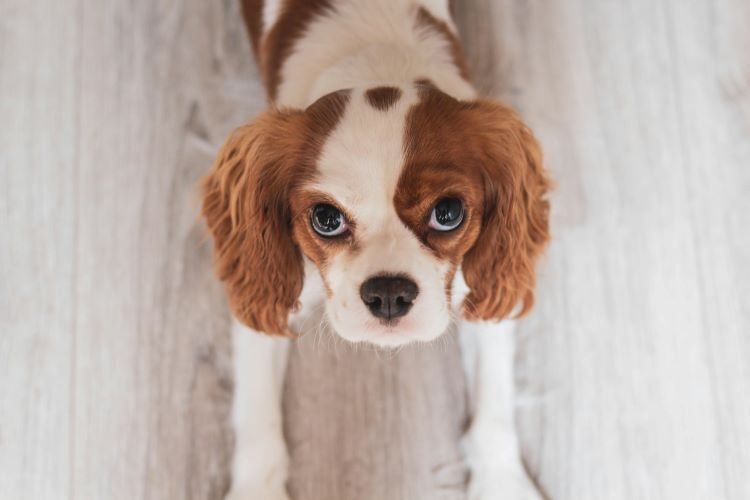Ready to help treat your pet to a healthy life?
A Guide to the Cavalier King Charles Spaniel
By : Trupanion Staff | Updated Jun 13, 2024

Welcome to the world of the Cavalier King Charles Spaniel, a breed known for its expressive eyes, silky coat, and affectionate nature. Originating from the UK, these small but sturdy dogs are perfect companions, blending the gentle lapdog of yesteryear with the sporting spaniel of today. They are friendly, adaptable, and get along well with children and other pets. Whether you're looking for a playful partner or a snuggle buddy, the Cavalier King Charles Spaniel is sure to bring joy and love to any household.
Ready to learn more about these unique and personable pups? We've put together this handy breed guide with everything you need to know. But first, some fun facts.
8 unique facts about the Cavalier King Charles dog
- Wondering about that regal name? The breed gets its moniker from King Charles II of Britain (who ruled in the 1600s).
- Cavalier King Charles Spaniels are a relatively new breed.
But toy spaniels, the canines used to create the breed, have been around since the 1500s.
- Some historians say lapdogs like the Cavalier King Charles Spaniel had a special job in the past: to prevent the spread of the plague and other diseases! It was believed they’d attract fleas, helping to keep the fleas from biting people. So, they allowed dogs to sleep in the bed.
- Cavaliers are sweet and very adaptable, which makes them a great breed for first-time dog owners. But they’re also prone to separation anxiety if left alone too often, especially as puppies, which can be challenging for certain lifestyles.
- Despite their small stature, they are naturally athletic dogs and excel at a wide range of energetic activities.
- The Cavalier King Charles is regarded as an excellent choice for a therapy dog, and many have served this role in recent decades.
- As a small dog breed, they tend to have long lifespans. Life expectancy for these pups is between 10 and 15 years.
- They come in four distinctive color patterns (more on this below).
Get to know the breed
The Cavalier has big round eyes, giving them an almost-human expression. They’re also known for fuzzy feet. In fact, the breed standard requires the long fur that grows on top of their feet to be natural and floppy. The Cavalier community lovingly refers to this as “Grinch” feet.
The breed comes in 4 different colors, and each has a special name:
- Prince Charles: Tri-color (black, tan, and white)
- Ruby: Chestnut or mahogany
- Blenheim: Chestnut and white
- King Charles: Black and tan
Personality
The Cav is a perfect combination of posh and hardy. One of the larger toy breeds, they’re adaptable and easy to train. This breed is affectionate and easy-going in most situations, as long as they’re with their people. With such adorable features, they’re a magnet for attention, but may act timid if they feel overwhelmed.
Similar dog breeds
- English Toy Spaniel
- Cocker Spaniel
- Japanese Chin
- Pug
- English Springer Spaniel

History of the Cavalier King Charles Spaniel
The Cavalier King Charles Spaniel is woven into the fabric of British royal history. Toy spaniels were common among the ruling houses as companions (and, oddly, heat sources). In fact, King Charles II, known as the “Cavalier King,” was said to be so distracted by his toy spaniels that he ignored his royal duties.
After he died in 1685, the breeding of toy spaniels continued. Some houses crossed them with other breeds, like Pugs or Papillons, to achieve a flatter face or more obvious ear feathering. And by the 19th-century, spaniels began to resemble the modern-day English Toy Spaniel, which has a flatter-face and smaller size than the modern Cavalier King Charles Spaniel.
In 1926, a wealthy American named Roswell Eldridge offered a cash prize at Crufts for a breeder showing a Restoration-style toy spaniel, with a longer muzzle, flatter head, and higher set ears, reminiscent of the dogs the “Cavalier King” Charles II preferred. Breeders set about refining their puppies to better match this ancestral style, and the Cavalier King Charles Spaniel was born.
The Cavalier breed club was formed in 1928 and the breed had a moderate rise in popularity in the United Kingdom. During World War II, however, the breeding population became dangerously low, with only 60 registered Cavaliers between 1940 and 1945. After the war ended, the Kennel Club (UK) officially recognized the breed and it regained popularity as a companion dog.
The Cavalier King Charles Spaniel first made its way across the pond in the mid-1950s with W. Lyon Brown, who went on to co-found the Cavalier King Charles Club U.S.A. The AKC officially recognized the breed in 1995, and the Cavalier has since enjoyed quite a boost in popularity, consistently ranking in the top 20 most popular breeds in the United States.
Behavior and training
The Cavalier was bred for companionship but still retains a spaniel’s sturdiness and desire to chase things like squirrels and birds. And they aren’t scared to chase after moving vehicles or bicycles either, so it’s important to keep them in a secure yard or on a leash for safety.
They require a good amount of attention — if left alone too long, Cavaliers can become quite anxious. They love and need company, making them ideal for empty-nesters or elderly owners who have time to dedicate.
Do these dogs get along with others?
- Cavaliers can be very social but may need time to warm up to new people and experiences. Proper proactive exposure to new sights, sounds, people, dogs, and other animals as a young puppy is essential for their socialization skills.
- As one of the larger toy breeds, Cavalier King Charles Spaniels do well in homes with children. Make sure they’ve been properly introduced and socialized with children as a young puppy to set them up for success. Young children and dogs should always be supervised, and it’s helpful for a dog to have their own “safe space” where they can go when they need some quiet time.
- Cavaliers can enjoy the companionship of other animals in the home with proper introductions. Due to their tendency for separation anxiety, many Cavalier owners have more than one so they can keep each other company.
Exercise and mental enrichment
Though they’re a toy breed, Cavaliers do need a good amount of physical exercise each day. Not only does this help keep them at a healthy weight, but also helps prevent separation anxiety. Daily walks and playtime are excellent ways to exercise a Cavalier. They especially love playing fetch with their squeaky toys.
Cavalier King Charles Spaniels enjoy having puzzles to solve and love exploring the world through smell during their walks. Daily training for obedience or tricks is a great way to provide enrichment, keep their brain sharp, and build the human-canine bond.
Behavioral issues
Cavaliers are prone to separation anxiety. They need positive exposure to alone time from puppyhood, to prevent or minimize any separation anxiety issues as they get older. It’s much easier to prevent than to treat. Make alone time a positive and relaxing experience for your Cavalier King Charles.
These spaniels are known for taking off after squirrels, birds, cars, or whatever catches their fancy! While this prey drive makes them excellent at playing fetch or competing in flyball, it can make for quite a dangerous situation. It’s best to keep your Cavalier on a leash or in a securely fenced yard and practice your come-when-called training.
Activities for the Cavalier King Charles Spaniel
These pups enjoy a variety of dog sports and activities, especially those that keep them close to their humans:
- Flyball
- Therapy Work
- Canine Freestyle
- Agility
- Rally Obedience
Grooming and health care
Cavaliers have a single or double-layered wavy and silky coat that is left “au naturale” and grows to a medium length. The longest fur is found on their ears, chest, feet, and feathers on the back of the legs.
The Cavalier’s unique coat requires regular brushing (at least twice a week) to keep it healthy and prevent tangling. They do shed, but frequent brushing and regular baths will keep this manageable. This breed doesn’t usually need trimming or cutting of the coat, except for the bottom of the Cavalier’s paws where the fur grows between the paw pads and makes it hard to walk without slipping. Introduce your Cavalier puppy to the grooming experience in a calm and positive way to make lifelong grooming needs easy and less stressful for everyone.
Common health conditions
Like all dog breeds, Cavaliers are prone to certain health conditions over others. Their breed alone does not guarantee they'll get sick — a lot of different factors are at play (including genetics, lifestyle, nutrition, and just luck). But as a responsible pet owner, it's a good idea to be aware of the types of illnesses and other health conditions your dog may be at higher risk for and protect them with dog insurance in the meantime.
Common conditions in the Cavalier King Charles include (but are not limited to):
- Mitral Valve Disease (MVD): A heart condition that affects many Cavaliers, often leading to heart failure. It's one of the most prevalent issues in the breed.
- Syringomyelia (SM): A serious neurological condition where fluid-filled cavities develop within the spinal cord, causing pain and discomfort.
- Hip Dysplasia: A genetic condition where the hip joint doesn't fit properly into the hip socket, leading to arthritis and pain.
- Patellar Luxation: A condition where the kneecap dislocates, causing lameness and pain.
- Ear Infections: Due to their long, floppy ears, Cavaliers are prone to ear infections, which can cause discomfort and hearing issues.
- Eye Problems: They can suffer from various eye conditions, including cataracts, retinal dysplasia, and progressive retinal atrophy (PRA).
- Obesity: Like many small breeds, Cavaliers can easily become overweight, leading to various health issues such as diabetes and joint problems.
Regular veterinary check-ups and a healthy lifestyle can help manage and prevent some of these conditions.

The Cavalier King Charles in pop culture
Thanks to its regal, distinctive appearance and sweet nature, the Cavalier King Charles is no stranger to fame.
Famous owners
- Brad Paisley & Kimberly Williams Paisley (Singer & Actress)
- Julianne Hough (Dancer)
- Sylvester Stallone (Actor)
- Frank Sinatra (Singer)
- Diane Sawyer (Journalist)
- Kristin Davis (Actress)
- Teri Hatcher (Actress)
- Princess Margaret (Royalty)
- Seth Rogan (Actor)
- Tom Selleck (Actor)
Cavalier King Charles Spaniels in media
- Reese from the movie The Age of Adaline
- The dogs from the movie, Unleashing Mr. Darcy
- Charlotte’s dog, Elizabeth Taylor, on the TV series, Sex & the City
- Dash, Queen Victoria’s companion, who is played by the same Cavalier King Charles Spaniel in both the movie, The Young Victoria, and TV show, Victoria
